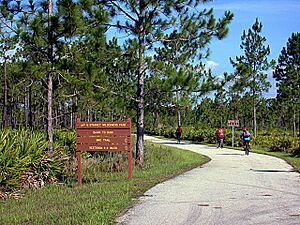Starkey Wilderness Preserve facts for kids
The Starkey Wilderness Preserve is a large natural area in Pasco County, Florida. It's a special place where people can enjoy nature and help protect the environment. This preserve offers many fun activities like hiking, biking, and horseback riding on its trails. You can also find cabins and camping spots, plus picnic areas for a day out.
The preserve is named after Jay B. Starkey, a cattle rancher who bought the land in 1937. He later gave hundreds of acres to be protected. The preserve is made up of three main parts: the Jay B. Starkey Wilderness Park (managed by Pasco County), and the Serenova Tract and Anclote River Ranch Tract (both managed by the Southwest Florida Water Management District).
Contents
Exploring Starkey Wilderness Preserve
This amazing area covers about 8,500 acres (which is about 34 square kilometers) of different natural habitats. It's part of a much larger "wetland ecosystem" that spreads across around 18,000 acres of protected land. The preserve is located in Western Pasco County, just east of New Port Richey.
What Can You Do There?
Starkey Wilderness Preserve is a fantastic place for outdoor adventures.
Trails for Everyone
The preserve has a great network of trails. The Starkey Trail is a paved path about 6.7 miles (10.8 kilometers) long. It's perfect for walking, running, or biking and connects to the Suncoast Trail at its eastern end. There are also many unpaved trails for those who want a more rugged experience. In 2013, plans were approved to build an 8-mile (12.9 kilometer) mountain bike trail, adding even more options for adventure seekers.
Camping and Picnics
If you love spending time outdoors, you can find primitive camping sites where you can truly connect with nature. There are also cabins available for a more comfortable stay. Picnic areas are set up for families and friends to enjoy meals together surrounded by the beautiful scenery.
Nature's Habitats
The preserve is home to many different types of environments, which means it supports a wide variety of plants and animals.
Pine Flatwoods
These areas are covered with tall pine trees and have an open understory, meaning not many small plants grow beneath them. They are often found in flat, low-lying areas.
Cypress Domes
Cypress domes are unique wetlands where cypress trees grow in a circular shape, often in a depression that collects water. The trees in the center are usually taller than those on the edges, giving them a dome-like appearance.
Freshwater Marshes
These are wetlands filled with non-woody plants like grasses and reeds, and they are always wet. They are important habitats for many birds, amphibians, and insects.
Stream and Lake Swamps
These are forested wetlands found along streams and lakes. They are usually flooded for long periods and are home to trees that can tolerate wet conditions, such as cypress and various types of gum trees.
Sandhill and Scrub
These habitats are drier and have sandy soils. Sandhills are open woodlands with pine trees and a grassy understory. Scrub areas have dense, low-growing shrubs and small trees, adapted to dry, sandy conditions.


